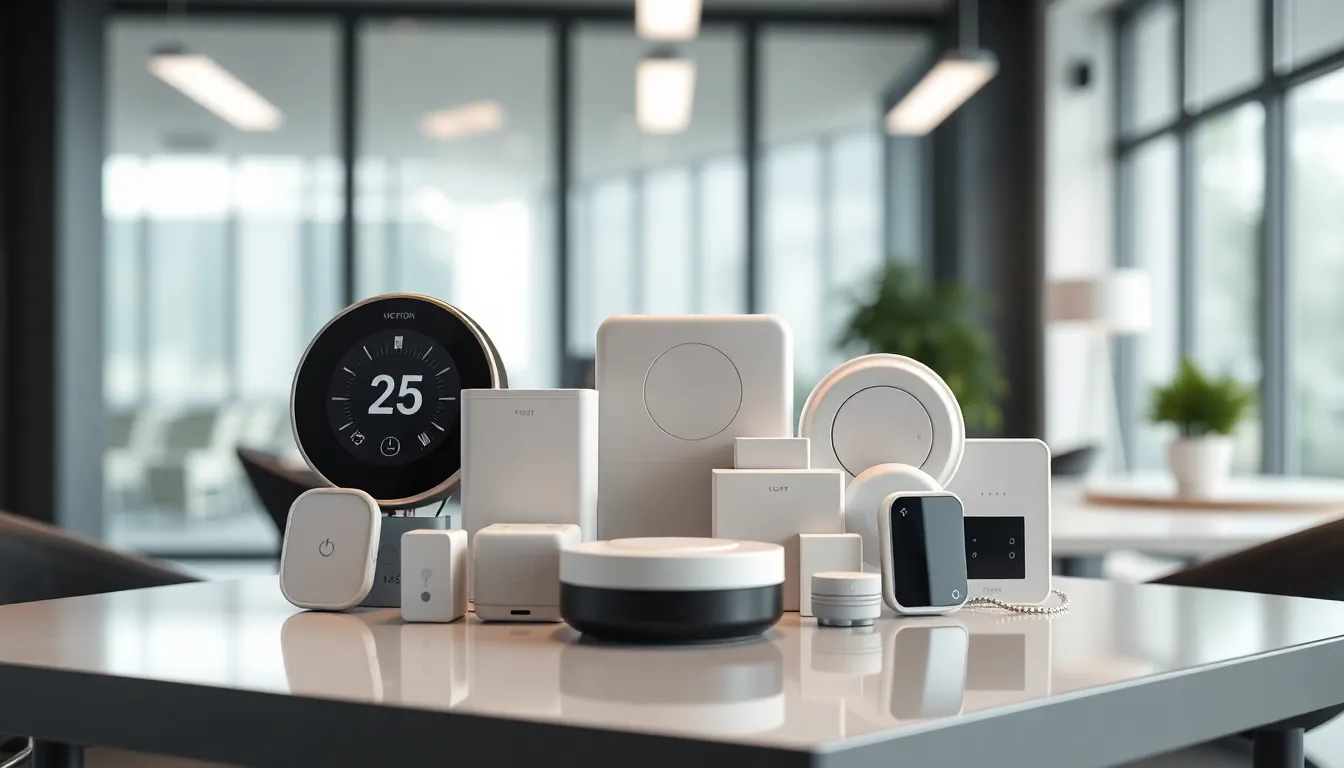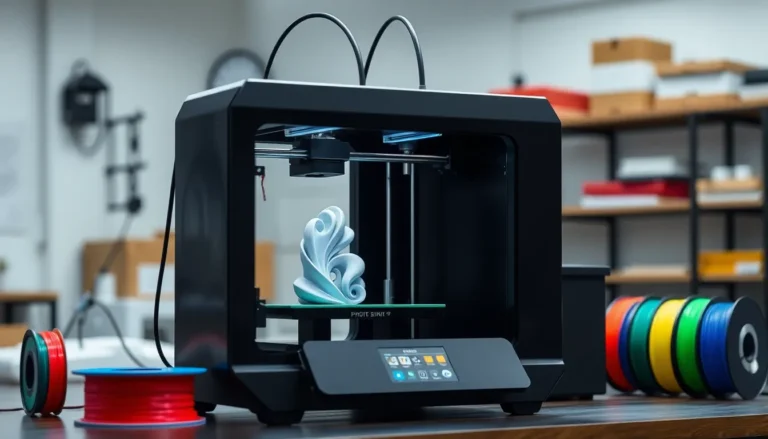Table of Contents
ToggleIn a world where your toaster might just have a better social life than you, IoT frameworks are the unsung heroes keeping everything connected. These frameworks act like the invisible glue that binds smart devices, ensuring they communicate seamlessly. Without them, your fridge wouldn’t know when to order more milk, and your thermostat would be as confused as a cat in a dog park.
As technology evolves at lightning speed, understanding IoT frameworks becomes crucial for businesses and tech enthusiasts alike. They’re not just buzzwords; they’re the backbone of a smarter, more efficient future. Dive into the fascinating world of IoT frameworks and discover how they’re shaping our daily lives, one smart device at a time. Who knew that behind every smart gadget lies a complex web of frameworks just waiting to make life a little easier—and a lot more interesting?
Overview of IoT Frameworks
IoT frameworks form the backbone of the Internet of Things ecosystem. These frameworks streamline communication between various smart devices, helping them function cohesively. Key components include protocols, software, and hardware that work together seamlessly.
Protocols play a significant role in facilitating connectivity. They define how devices send and receive data, ensuring accuracy and reliability. Common protocols include MQTT, CoAP, and HTTP, each designed for specific use cases in IoT environments.
Software components within these frameworks manage data processing and device integration. Middleware solutions often act as intermediaries, simplifying interactions among diverse devices and applications. Examples of middleware platforms include AWS IoT and Azure IoT Hub, which support scalability and security.
Hardware components are equally vital. Microcontrollers, sensors, and gateways enable physical device operation and data transmission. Manufacturers utilize various technologies to enhance sensor accuracy, battery life, and overall performance.
Security also remains paramount in IoT frameworks. Robust security measures, such as encryption and authentication, protect against unauthorized access and data breaches. Implementing strong security protocols minimizes risks associated with connected devices.
Interoperability defines how well different systems and devices work together. Successful IoT frameworks emphasize compatibility, allowing devices from different manufacturers to communicate and share data. This integration fosters enhanced functionality and user experience.
Scalability ensures frameworks can adapt to growing device networks. As more devices connect, effective frameworks need the capability to manage increased data loads without compromising performance. This adaptability is crucial for evolving IoT ecosystems.
IoT frameworks provide essential structures for efficient device communication and management. Their roles in protocol implementation, software integration, hardware functionality, security, interoperability, and scalability underscore their importance in shaping the IoT landscape.
Key Components of IoT Frameworks

Key components form the foundation of IoT frameworks, enabling smooth interactions among devices and ensuring effective data management. Important factors include devices and sensors, communication protocols, and data management systems.
Devices and Sensors
Devices and sensors play crucial roles in the IoT ecosystem. Microcontrollers execute specific tasks while facilitating communication between hardware components. Sensors, such as temperature, motion, or pressure sensors, collect data and provide insights for monitoring environments. Together, they drive automation in smart homes and industries. Integrating these devices creates a network that enhances functionality and responsiveness.
Communication Protocols
Communication protocols are essential for ensuring seamless connectivity. MQTT, CoAP, and HTTP facilitate interactions between devices and servers. Each protocol serves specific use cases, such as low-bandwidth or high-availability scenarios. Effective communication lowers latency and improves efficiency in data transmission. Understanding protocol requirements allows developers to choose the right solutions for diverse applications.
Data Management
Data management in IoT frameworks ensures proper handling of the vast amounts of information generated. Middleware solutions integrate device data, processing inputs and outputs for analysis. Cloud platforms such as AWS IoT and Azure IoT Hub streamline processes, improving storage, retrieval, and security. Real-time analytics empower users to make informed decisions based on significant data trends, enhancing overall performance. Consistent data management fosters reliable communication across the IoT landscape.
Popular IoT Frameworks
IoT frameworks encompass various solutions designed to streamline connectivity and management of smart devices. Below are two prominent frameworks that exemplify these capabilities.
Framework 1: Overview and Features
AWS IoT Core stands out as a leading framework for IoT applications. It allows secure device connectivity and offers features like MQTT and HTTP support for efficient data transmission. Device management capabilities enable remote monitoring and updates, enhancing operational efficiency. AWS IoT Core integrates seamlessly with other AWS services, facilitating data processing and analytics. This framework ensures robust security measures, including encryption and fine-grained access control, protecting device data.
Framework 2: Overview and Features
Microsoft Azure IoT Hub offers comprehensive solutions for managing IoT devices. It supports bi-directional communication, allowing devices to send and receive messages effectively. Azure IoT Hub provides scaling capabilities, accommodating thousands of devices within a single solution. It includes features such as device provisioning and monitoring, ensuring streamlined operations. By integrating with Azure’s cloud services, this framework simplifies data analysis and real-time decision-making, enhancing overall performance and scalability.
Benefits of Using IoT Frameworks
Increased efficiency stands out as a primary benefit of IoT frameworks. Such frameworks streamline device communication, minimizing latency and enhancing response times. Enhanced interoperability also plays a crucial role, allowing diverse devices to work together seamlessly. Smart home devices, industrial systems, and wearables benefit significantly from this compatibility.
Scalability emerges as another vital advantage. Frameworks accommodate growing networks effortlessly, ensuring performance remains stable as additional devices connect. As IoT ecosystems expand, this adaptability becomes essential for managing increased data traffic.
Improved security measures within IoT frameworks offer protection against potential threats. Encryption techniques safeguard data during transmission while authentication protocols verify device identities. This focus on security fosters user trust, encouraging broader adoption of smart technology.
Notable cost savings are achieved through optimized resource usage. By automating processes and integrating devices, frameworks reduce operational expenses in various industries. Retailers experience decreased inventory management costs as they implement real-time tracking through IoT solutions.
Data management capabilities contribute to better decision-making. Effective frameworks facilitate data collection, storage, and analysis, providing valuable insights for businesses. Real-time analytics support quick responses to changing conditions, enhancing operational agility.
Lastly, IoT frameworks foster innovation in product development. Developers use these structures to create new applications, pushing the boundaries of what smart technology can accomplish. With constant advancements, the potential for unique solutions continues to grow, benefiting various sectors.
Challenges in Implementing IoT Frameworks
Implementing IoT frameworks presents several challenges. Security vulnerabilities rank among the top concerns, as connected devices often become targets for cyberattacks. Encryption and authentication, while essential, may complicate the development process. Integration of diverse devices from multiple manufacturers remains difficult; interoperability issues arise when systems can’t communicate effectively.
Scalability poses another significant hurdle. As the number of devices grows, frameworks must manage increased data loads without sacrificing performance. Migrating existing infrastructure to accommodate new technologies can result in operational disruptions. Additionally, maintaining a consistent user experience across various platforms presents complexities.
Latency contributes to the challenges as well. Real-time data transmission is crucial in many applications, yet network delays can lead to inefficiencies. Optimizing communication protocols is vital, but it requires a thorough understanding of both hardware and software components. Moreover, the need for continuous updates and maintenance of frameworks can strain resources, making long-term management a complex endeavor.
Cost is a factor that cannot be overlooked. Developing and deploying IoT frameworks often involves high initial investments, particularly regarding infrastructure and skilled personnel. Organizations must also account for ongoing costs such as device management and software licensing. Despite these challenges, staying competitive in the rapidly evolving IoT landscape confirms the importance of navigating these obstacles effectively.
The evolution of IoT frameworks is pivotal for shaping a more connected world. By enhancing communication among devices they enable smarter environments that improve daily life. The integration of robust security measures and efficient data management ensures that these frameworks can handle the increasing complexity of interconnected systems.
As technology continues to advance the significance of IoT frameworks will only grow. They not only facilitate seamless interactions among devices but also foster innovation and efficiency across various industries. Embracing these frameworks is essential for anyone looking to harness the full potential of the Internet of Things and stay ahead in a rapidly changing landscape.








